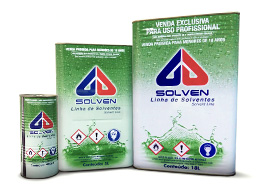
Solven ECO T-13 Specification and Safety Information
DESCRIPTION
It is a colorless liquid, free of suspended materials. It is mainly composed of aliphatic hydrocarbons. This low content of aromatics is obtained by Catalytic Hydrogenation, which reduces aromatics, sulfur, saturates olefins and eliminates polar impurities.
It is a product recognized as “Ready Biodegradable” by the criteria of the American OECD. Biodegradability in 28 days is 80%.
PROPERTIES
See the tests, specification, Solven method and reference method in the PDF file available for download.
APPLICATION / MAIN USES
It is an ideal solvent for industrial cleaning and degreasing techniques and protective waxes. Combined with certain emulsifiers it is used in the formation of cleaning products. It is used in temporary protective coatings for the transport of manufactured products, machine spare parts, among others.
PACKAGING, STORAGE AND HANDLING
Product must be kept away from sources of ignition, in a cool, dry place, protected from bad weather. The supply is made through drums, cans, cans, containers and in bulk. The shelf life of this product is 24 months from the date of manufacture, under the recommended storage conditions and/or original packaging.
CLASSIFICATION FOR TRANSPORT
UN number: 3295.
Proper shipping name: Liquid Hydrocarbons, N.E.
Risk class / division: 3.
Risk number: 30.
Subsidiary risk: N.A.
Packing Group: III.
ADOPTED CLASSIFICATION SYSTEM
Standard ABNT-NBR 14725-Part 2: 2009. Adoption of the Globally Harmonized System for the Classification and Labeling of Chemicals, UN.
STORAGE
P402+P403+P404 Store in a dry place. Store in a well-ventilated place. Store in a closed container.
PHYSICAL AND CHEMICAL PROPERTIES
Aspect:
- Physical state: Liquid;
- Appearance: Clear;
- Color: Colorless.
Odor: Low odor, but characteristic of hydrocarbons.
Odor threshold: Not available.
pH: Not Available.
Melting point/freezing point: Not available.
Initial boiling point and boiling temperature range: 140 – 175 °C (Distillation Range).
Flash point: > +34 °C.
Evaporation rate: Not available.
Flammability: Not Available.
Lower/upper limit of flammability or explosiveness: Upper (LSE): 6.5%, Lower (LIE): 0.6%.
Vapor Pressure: Not Available.
Vapor Density: Not Available.
Relative density: 0.768 – 0.788 (water as standard).
Solubilities: Not Available.
Partition coefficient – n-octanol/water: Not available.
Auto-ignition temperature: > 250°C (ASTM E659-78).
Decomposition temperature: Not available.
Viscosity: Not Available.
STABILITY AND REACTIVITY
Reactivity: Not Available.
Chemical stability: Stable under normal conditions of use.
Possibility of hazardous reaction: Not available.
Conditions to Avoid: Heat, ignition sources, incompatible materials.
Incompatible Materials: Strong Acids and Oxidizing Agents.
Hazardous decomposition products: On combustion, the formation of toxic decomposition products cannot be excluded.
TOXICOLOGICAL INFORMATION
Acute toxicity:
- Skin Corrosion/Irritation: Repeated or prolonged contact may dry out and cause mild skin irritation;
- Serious eye damage/eye irritation: May cause irritation in contact with eyes;
- Respiratory or skin sensitization: Vapors may cause drowsiness and dizziness. Inhalation of vapors can cause respiratory and mucosal irritations, headaches, nausea, vomiting;
- Germ cell mutagenicity: Insufficient information for classification;
- Carcinogenicity: Insufficient information for classification;
- Reproductive toxicity: Insufficient information for classification;
- Specific target organ toxicity – single exposure: Vapors may cause drowsiness and dizziness;
- Specific target organ toxicity – repeated exposure: Insufficient information for classification;
- Aspiration Hazard: Product can enter lungs and cause damage such as: Chemical Pneumonia.
ECOLOGICAL INFORMATION
Ecotoxicity: Not Available.
Persistence and Degradability: Readily Biodegradable – 80% after 28 days (Method: OECD 301F).
Bioaccumulative Potential: Not Available.
Ground mobility: Not available.
Other Adverse Effects: Not Applicable.
CONSIDERATIONS ON FINAL DESTINATION
Recommended disposal methods: This product can be reprocessed, incinerated in suitable facilities or sent for co-processing. Check in your Municipality and/or in your State, the applicable legislation on final disposal.
Used packaging: When the container is empty, contaminated with the product, it can be sent to recycling companies.